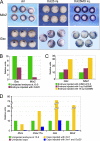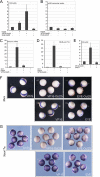Oct25 represses transcription of nodal/activin target genes by interaction with signal transducers during Xenopus gastrulation
- PMID: 18922797
- PMCID: PMC2662234
- DOI: 10.1074/jbc.M803532200
Oct25 represses transcription of nodal/activin target genes by interaction with signal transducers during Xenopus gastrulation
Abstract
The balance between differentiation signals and signals maintaining the undifferentiated state of embryonic cells ensures proper formation of germ layers. The nodal/activin pathway represents one of the major signaling chains responsible for the differentiation of embryonic cells into mesodermal and endodermal germ layers, while Oct4 is one of the major players in the maintenance of an undifferentiated state. Here we show that Oct25, an Oct4 homologue in Xenopus, antagonizes the activity of nodal/activin signaling by inhibiting the transcription of its target genes, Gsc and Mix2. The inhibitory effect is achieved by forming repression complexes on the promoters of Gsc and Mix2 between Oct25 and the signal transducers of the nodal/activin pathway, WBSCR11, FAST1, and Smad2. We have analyzed the significance of the Oct binding site for its inhibitory effect within the Gsc promoter. Albeit VP16-Oct25 fusion protein demonstrated a stimulating effect and EVE-Oct25 revealed a repression effect on an artificial reporter that is composed of eight repeats of Oct binding motifs, both fusions, like wild-type Oct25, inhibited mesendoderm formation and the activity of Gsc and Mix2 promoters. These results suggest that the regulatory effect of Oct25 on the expression of Gsc and Mix2 is mediated by specific protein/protein interactions. Furthermore, we demonstrate that histone deacetylase activities are not required for the inhibitory effect of Oct25. Our results provide a novel view in that Oct25 controls the nodal/activin pathway and thus maintains the undifferentiated state of embryonic cells in preventing them from premature differentiation.
Figures








Similar articles
-
Xenopus POU factors of subclass V inhibit activin/nodal signaling during gastrulation.Mech Dev. 2006 Aug;123(8):614-25. doi: 10.1016/j.mod.2006.06.004. Epub 2006 Jun 14. Mech Dev. 2006. PMID: 16860542
-
Negative regulation of Activin/Nodal signaling by SRF during Xenopus gastrulation.Development. 2007 Feb;134(4):769-77. doi: 10.1242/dev.02778. Development. 2007. PMID: 17259304
-
Identification of a novel negative regulator of activin/nodal signaling in mesendodermal formation of Xenopus embryos.J Biol Chem. 2009 Jun 19;284(25):17052-17060. doi: 10.1074/jbc.M109.007443. Epub 2009 Apr 22. J Biol Chem. 2009. PMID: 19389709 Free PMC article.
-
Molecular regulation of Nodal signaling during mesendoderm formation.Acta Biochim Biophys Sin (Shanghai). 2018 Jan 1;50(1):74-81. doi: 10.1093/abbs/gmx128. Acta Biochim Biophys Sin (Shanghai). 2018. PMID: 29206913 Review.
-
Differential response of epiblast stem cells to Nodal and Activin signalling: a paradigm of early endoderm development in the embryo.Philos Trans R Soc Lond B Biol Sci. 2014 Dec 5;369(1657):20130550. doi: 10.1098/rstb.2013.0550. Philos Trans R Soc Lond B Biol Sci. 2014. PMID: 25349457 Free PMC article. Review.
Cited by
-
Reversal of Xenopus Oct25 function by disruption of the POU domain structure.J Biol Chem. 2010 Mar 12;285(11):8408-21. doi: 10.1074/jbc.M109.064386. Epub 2010 Jan 11. J Biol Chem. 2010. PMID: 20064932 Free PMC article.
-
The Xenopus Maternal-to-Zygotic Transition from the Perspective of the Germline.Curr Top Dev Biol. 2015;113:271-303. doi: 10.1016/bs.ctdb.2015.07.021. Epub 2015 Aug 21. Curr Top Dev Biol. 2015. PMID: 26358876 Free PMC article. Review.
-
Nodal and <i>churchill1</i> position the expression of a notch ligand during <i>Xenopus</i> germ layer segregation.Life Sci Alliance. 2022 Sep 30;5(12):e202201693. doi: 10.26508/lsa.202201693. Life Sci Alliance. 2022. PMID: 36180230 Free PMC article.
-
Suv4-20h histone methyltransferases promote neuroectodermal differentiation by silencing the pluripotency-associated Oct-25 gene.PLoS Genet. 2013;9(1):e1003188. doi: 10.1371/journal.pgen.1003188. Epub 2013 Jan 31. PLoS Genet. 2013. PMID: 23382689 Free PMC article.
-
Genome-wide view of TGFβ/Foxh1 regulation of the early mesendoderm program.Development. 2014 Dec;141(23):4537-47. doi: 10.1242/dev.107227. Epub 2014 Oct 30. Development. 2014. PMID: 25359723 Free PMC article.
References
-
- Ariizumi, T., Sawamura, K., Uchiyama, H., and Asashima, M. (1991) Int. J. Dev. Biol. 35 407-414 - PubMed
-
- Green, J. B., and Smith, J. C. (1990) Nature 347 391-394 - PubMed
-
- Gurdon, J. B., Harger, P., Mitchell, A., and Lemaire, P. (1994) Nature 371 487-492 - PubMed
-
- Jones, C. M., Kuehn, M. R., Hogan, B. L., Smith, J. C., and Wright, C. V. (1995) Development 121 3651-3662 - PubMed
Publication types
MeSH terms
Substances
LinkOut - more resources
Full Text Sources
Molecular Biology Databases
Research Materials

